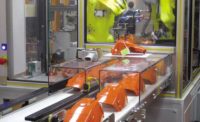Based in the Chicago suburb of Wheeling, IL, Precision Zone Inc. specializes in repairing electric motors and industrial electronics, such as AC and DC drives, power supplies, controls and displays. With a staff of some 50 professionals, the company also takes on small automation and tooling projects, as well as low-volume contract manufacturing projects.
The company not only integrates and installs robots for customers, it also employs robots for its own production needs. Recently, Precision Zone engineers discovered ABAGY software from ABAGY Robotic Systems. ABAGY is vision-based software for no-code, on-the-fly programming of welding robots.
Russian engineer Maxim Zverkov founded ABAGY in 2016 after facing difficulties getting robots to weld metal furniture and other structures. Although robots have been proven to increase productivity, they are still only used in a fraction of potential applications. There are two reasons for that, argues Zverkov. First, every move a robot makes must be programmed, a process that can take several hours or several weeks. Second, actual production differs from ideal blueprints or CAD files. But, robots operate with little tolerance for deviations in the workpiece or its position.
ABAGY software was developed to overcome those limitations. No code is required. The software automatically generates a robot program to make a specific product. A program can be created in minutes. Then, using machine vision, the system scans the parts and adjusts the robot’s trajectories depending on the actual position of the product. The software is compatible with robots from several OEMs, including Kuka, Yaskawa, ABB and FANUС.
When Precision Zone’s engineers learned about ABAGY software, they recognized two opportunities for development. First, they realized the software would simplify the programming process for themselves. In addition, the software could open a new market before the company as an integrator for thousands of high-mix, low-volume manufacturers that could not use robots before.
The software payed immediate dividends for Precision Zone on a recent job to manufacture adjustable, tilting assembly tables. The table consists of seven major welded components. The table base alone requires 111 welds.
Instead of days of programming, ABAGY generated robot trajectories for all 111 welds in just 9 minutes—100 times faster than would have been possible with conventional programming techniques.
The program was generated automatically; a programmer was not required. Engineers only needed to upload a 3D model of the product (a step format file from any CAD system). The software indicates all potential welds in the model. The user then sets welding parameters and the weld sequence. After that, the software automatically generates robot movement trajectories based on the inputs.
It’s one thing to generate a program; it’s another to execute it. With ABAGY, robots can see with the help of machine vision. The robot easily determines the position of the part in the work area. Reference points and fixtures are not required. In addition, the robot automatically adapts to part deviations. If there is a difference between the 3D model and the real part, the robot can correct its trajectory on the fly.
The software makes it easy to switch from one product to another. In its robotic cell, Precision Zone can produce any parts that can be placed in the work zone. It can be other assembly tables or any other product.
For more information on robot software and robotic welding cells, visit ABAGY’s website here.



